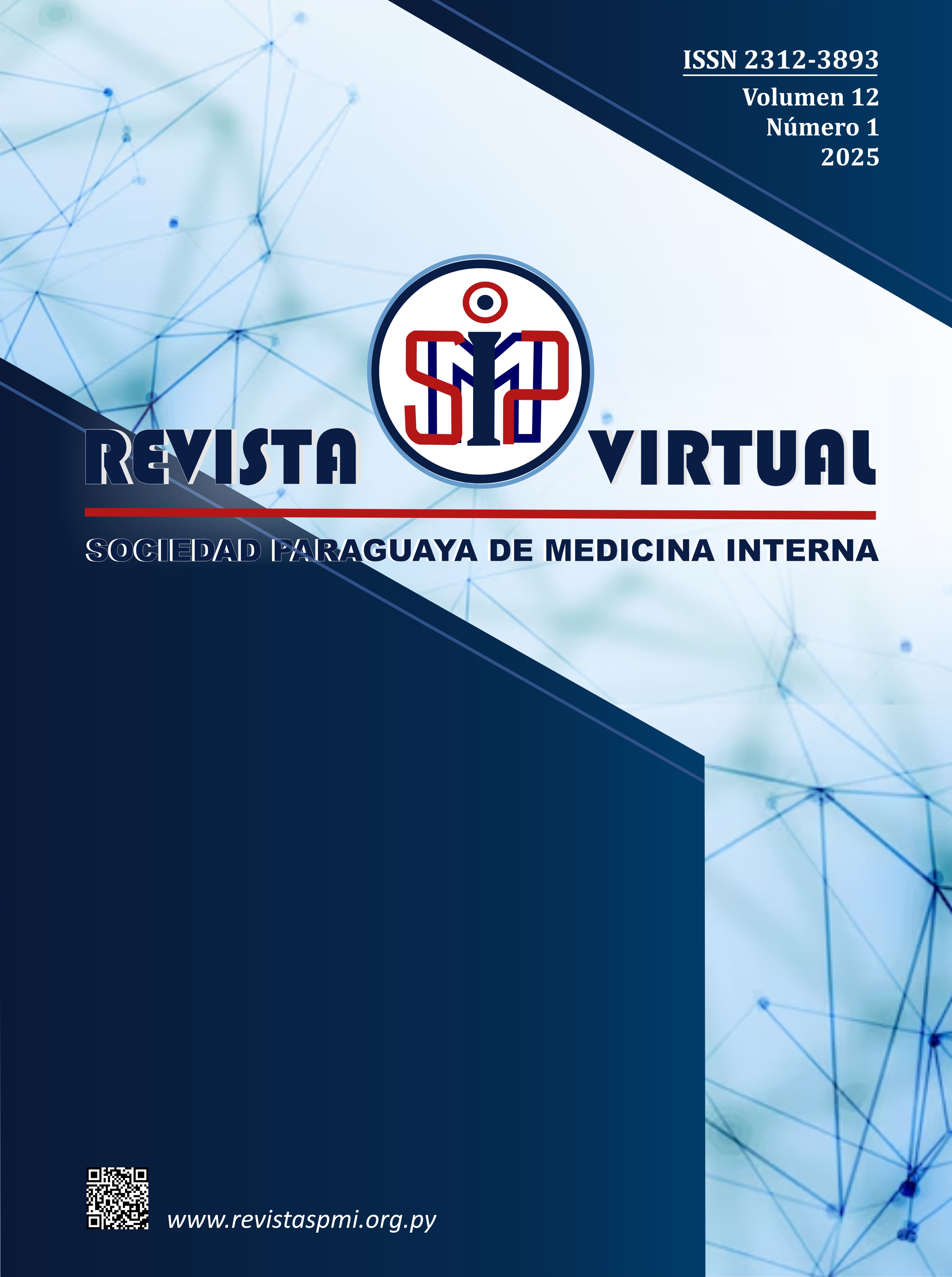Características clínicas de pacientes trasplantados renales y la frecuencia de infección por citomegalovirus del Hospital de Clínicas, periodo 2006- 2024
Resumen
Introducción: el trasplante renal es el tratamiento preferido para la enfermedad renal crónica terminal, mejorando la calidad de vida y la supervivencia. Sin embargo, la inmunosupresión necesaria eleva el riesgo de infecciones, destacando la infección por citomegalovirus, que puede causar complicaciones graves y comprometer la viabilidad del injerto y la supervivencia del paciente.
Objetivo: identificar las características clínicas de pacientes trasplantados renales y la frecuencia de infección por citomegalovirus.
Material y métodos: se realizó un estudio observacional, descriptivo, retrospectivo y transversal con muestreo no probabilístico de casos consecutivos, abarcando pacientes trasplantados renales del Hospital de Clínicas, 2006-2024. Se incluyeron pacientes con serología negativa pre trasplante y positiva postrasplante para citomegalovirus, excluyendo quienes recibieron profilaxis.
Resultados: se incluyeron 189 pacientes trasplantados renales, de los cuales 22,8% presentaron carga viral positiva para citomegalovirus. La mayoría eran hombres 66,7%, con una edad promedio de 38 años. El 43,9% no recibió profilaxis para citomegalovirus; 88,4% de los tratados usó ganciclovir y valganciclovir. Las principales comorbilidades fueron hipertensión arterial 65,6% y enfermedad renal crónica 96,3%. De los trasplantes, el 51,3% fueron de donantes vivos, con 84,1% de seropositividad donante+/receptor+. La infección activa por citomegalovirus ocurrió en 7% de pacientes con carga viral detectable.
Conclusión: se encontró 22,8% de pacientes carga viral detectable de citomegalovirus, en 7% infección activa y la frecuencia varió a lo largo del periodo. Las comorbilidades más frecuentes en los trasplantados renales fueron la hipertensión arterial y enfermedad renal crónica.
Citas
2. Ortiz Gómez LD, Rosado Alcocer LM, Ceballos Solís GJ, Salcedo Parra MA, Pool Cordero MB. Enfermedad renal crónica y factores de supervivencia en pacientes con trasplante renal: revisión de la literatura. Rev Salud y Bienestar Social [Internet]. 2021 [citado 4 Feb 2024];5(1):41-58. Disponible en: https://www.revista.enfermeria.uady.mx/ojs/index.php/Salud/article/view/91
3. Thongprayoon Ch, Hansrivijit P, Leeaphorn N, Acharya P, Torres-Ortiz A, Kaewput W, et al. Recent advances and clinical outcomes of kidney transplantation. J Clin Med [Internet]. 2020 [cited 2024 Feb 4];9(4):1193. Available from: https://pubmed.ncbi.nlm.nih.gov/32331309/. doi: 10.3390/jcm9041193
4. Crucio López M, Fernández Rivera C, Calvo Rodríguez M, Alonso Hernández Á. Infección por citomegalovirus resistente en un paciente trasplantado. Uso de letermovir y retirada de la inmunosupresión. Nefrología [Internet]. 2023 [citado 4 Feb 2024];43(5):661-2. Disponible en: https://www.revistanefrologia.com/es-infeccion-por-citomegalovirus-resistente-un-articulo-S021169952100206X. doi: 10.1016/j.nefro.2021.05.010
5. García Otero GA, Aceves Quintero CA, Corona Meléndez JC, Amaya Carreño MA. Colitis por cytomegalovirus en trasplante renal: Presentación de 2 casos. Rev Colomb Nefrol [Internet]. 2020 [citado 4 Feb 2024];7(1):113-20. Disponible en: http://www.scielo.org.co/scielo.php?script=sci_arttext&pid=S2500-50062020000100113&lng=en&nrm=iso&tlng=es. doi: https://doi.org/10.22265/acnef.7.1.338
6. Pacinella G, Ciaccio AM, Tuttolomondo A. Endothelial dysfunction and chronic inflammation: The cornerstones of vascular alterations in age-related diseases. Int J Mol Sci [Internet]. 2022 [cited 2024 Feb 4];23(24):15722. Available from: https://pubmed.ncbi.nlm.nih.gov/36555364/. doi: 10.3390/ijms232415722
7. Rodrigo E, Chedid MF, Segundo DS, San Millán JCR, López-Hoyos M. Acute rejection following kidney transplantation: State-of-the-Art and future perspectives. Curr Pharm Des. 2020;26(28):3468-96. doi: 10.2174/1381612826666200610184433
8. Cabezas L, Jouve T, Malvezzi P, Janbon B, Giovannini D, Rostaing L, Noble J. Tocilizumab and active antibody-mediated rejection in kidney transplantation: A literature review. Front Immunol [Internet]. 2022 [cited 2024 Ago 18];13: 839380 Available from: https://pubmed.ncbi.nlm.nih.gov/35493469/. doi: 10.3389/fimmu.2022.839380
9. Raval AD, Kistler KD, Tang Y, Murata Y, Snydman DR. Epidemiology, risk factors, and outcomes associated with cytomegalovirus in adult kidney transplant recipients: A systematic literature review of real-world evidence. Transpl Infect Dis. 2021;23(2): e13483. doi: 10.1111/tid.13483
10. Tang Y, Guo J, Li J, Zhou J, Mao X, Qiu T. Risk factors for cytomegalovirus infection and disease after kidney transplantation: A meta-analysis. Transpl Immunol. 2022; 74:101677. doi: 10.1016/j.trim.2022.101677
11. Abou-Jaoudé M, El Hage S, Akiki D, Fadlallah M, Ghaith AK, Dib A. Cytomegalovirus infection in kidney transplant patients: Prevalence, risk factors, and impact on outcome – A local multicentre experience. Transpl Immunol. 2021;69:101473. doi: 10.1016/j.trim.2021.101473
12. Diena D, Allesina A, Fop F, Mella A, Cavallo R, Costa C, et al. Relationship between cytomegalovirus viremia and long-term outcomes in kidney transplant recipients with different donor ages. Microorganisms [Internet]. 2023 [cited 2024 Ago 18];11(2):458. Available from: https://pubmed.ncbi.nlm.nih.gov/36838423/. doi: 10.3390/microorganisms11020458
13. Sagedal S, Nordal KP, Hartmann A, Sund S, Scott H, Degré M, et al. The impact of cytomegalovirus infection and disease on rejection episodes in renal allograft recipients. Am J Transplant [Internet]. 2002 [cited 2024 Ago 18] ;2(9):850-6. Available from: https://pubmed.ncbi.nlm.nih.gov/12392291/. doi: 10.1034/j.1600-6143.2002.20907.x
14. García-Prado ME, Cordero E, Cabello V, Pereira P, Torrubia FJ, Ruíz M, Cisneros JM. Complicaciones infecciosas en 159 receptores de trasplante renal consecutivos. Enferm Infecc Microbiol Clín [Internet]. 2009 [citado 18 Ago 2024];27(1):22-7. Disponible en: https://www.elsevier.es/es-revista-enfermedades-infecciosas-microbiologia-clinica-28-articulo-complicaciones-infecciosas-159-receptores-trasplante-S0213005X08000098. doi: 10.1016/j.eimc.2008.02.004
15. Pfirmann P, Garrigue I, Chauveau B, Rondeau V, Tumiotto C, Weinmann L, et al. Trends in epidemiology and risk factors of opportunistic infections in kidney transplant recipients between 2004 and 2017. Nephrol Dial Transplant [Internet]. 2024 [cited 2024 Ago 18];39(4):627-36. Available from: https://pubmed.ncbi.nlm.nih.gov/37667539/. doi: 10.1093/ndt/gfad193
16. Valencia Deray KG, Hosek KE, Chilukuri D, Dunson JR, Spielberg DR, Swartz SJ, et al. Epidemiology and long-term outcomes of cytomegalovirus DNAemia and disease in pediatric solid organ transplant recipients. Am J Transplant [Internet]. 2022 [cited 2024 Ago 18];22(1):187-98. Available from: https://pubmed.ncbi.nlm.nih.gov/34467658/. doi: 10.1111/ajt.16822
17. Han SH, Yoo SG, Do Han K, La Y, Kwon DE, Lee KH. The incidence and effect of cytomegalovirus disease on mortality in transplant recipients and general population: Real-world nationwide cohort data. Int J Med Sci [Internet]. 2021 [cited 2024 Ago 18];18(14):3333-41. Available from: https://pubmed.ncbi.nlm.nih.gov/34400903/. doi: 10.7150/ijms.62621
18. Rodríguez-Goncer I, Ruiz-Ruigómez M, López-Medrano F, Corbella L, Polanco N, González Monte E, et al. CMV infection, valganciclovir exposure, and the risk of BK viremia and associated nephropathy after kidney transplantation: Is there a link? Transpl Infect Dis. 2021;23(4): e13597. doi: 10.1111/tid.13597
19. Hellemans R, Wijtvliet V, Bergs K, Philipse E, Vleut R, Massart A, et al. A split strategy to prevent cytomegalovirus after kidney transplantation using prophylaxis in serological high-risk patients and a pre-emptive strategy in intermediate-risk patients: Combining the best of two options? Transpl Infect Dis. 2021;23(2): e13467. doi: 10.1111/tid.13467
20. Dadwal SS, Papanicolaou GA, Boeckh M. How I prevent viral reactivation in high-risk patients. Blood [Internet]. 2023 [cited 2024 Ago 18];141(17):2062-74. Available from: https://pubmed.ncbi.nlm.nih.gov/36493341/. doi: 10.1182/blood.2021014676
21. Forte E, Zhang Z, Thorp EB, Hummel M. Cytomegalovirus latency and reactivation: An intricate interplay with the host immune response. Front Cell Infect Microbiol [Internet]. 2020 [cited 2024 Sep 17];10: 130. Available from: https://pmc.ncbi.nlm.nih.gov/articles/PMC7136410/. doi: 10.3389/fcimb.2020.00130
22. Hassouneh F, Goldeck D, Pera A, van Heemst D, Slagboom PE, Pawelec G, Solana R. Functional changes of T-Cell subsets with age and CMV infection. Int J Mol Sci [Internet]. 2021 [cited 2024 Sep 17] ;22(18):9973. Available from: https://pubmed.ncbi.nlm.nih.gov/34576140/. doi: 10.3390/ijms22189973
23. Limaye AP, Babu TM, Boeckh M. Progress and challenges in the prevention, diagnosis, and management of cytomegalovirus infection in transplantation. Clin Microbiol Rev [Internet]. 2020 [cited 2024 Sep 17];34(1): e00043-19. Available from: https://pubmed.ncbi.nlm.nih.gov/33115722/. doi: 10.1128/CMR.00043-19
24. Chávez-Reyes J, Escárcega-González CE, Chavira-Suárez E, León-Buitimea A, Vázquez-León P, Morones-Ramírez JR, et al. Susceptibility for some infectious diseases in patients with diabetes: The key role of glycemia. Front Public Health [Internet]. 2021 [cited 2024 Sep 17];9: 559595. Available from: https://pubmed.ncbi.nlm.nih.gov/33665182/. doi: 10.3389/fpubh.2021.559595
25. Gugliesi F, Coscia A, Griffante G, Galitska G, Pasquero S, Albano C, Biolatti M. Where do we stand after decades of studying human cytomegalovirus? Microorganisms [Internet]. 2020 [cited 2024 Sep 17];8(5):685. Available from: https://pmc.ncbi.nlm.nih.gov/articles/PMC7284540/. doi: 10.3390/microorganisms8050685

















